Representations of the imperial family appear on a small number of tokens from Roman Italy. Emperors, empresses and their offspring are named and/or shown on these specimens. Some of these tokens may have been issued on behalf of the emperor; others carry reference to the authority of magistrates or groups. Tokens are thus a medium that communicated both official and non-official representations of imperial power. They form an important, and to date overlooked, source for the reception and use of imperial ideology by differing groups. For those outside the imperial government, the use of imperial imagery offered an opportunity to express a particular connection with the ruling power; the imagery also contributed to status and, subsequently, social structure.Footnote 1 In this way the imperial image, as well as tokens themselves as artefacts, contributed to the maintenance of social hierarchy and social relationships.
The emperor’s image was likely employed on tokens used during imperial celebrations; at least this is what is suggested by some of the messages carried on these pieces. Although it is dangerous to unthinkingly connect a particular image to a particular purpose, several of these tokens make reference to specific ceremonies through their legends (dies imperii, triumphs, liberalitas distributions). This suggests that at least some of these pieces were used in such contexts. The following chapter explores how tokens might be used to identify how the imperial image, and imperial ideology, were mobilised at specific moments in time. Festive celebrations offered an opportunity for people to actively engage with the imagery of the imperial family. These event-based, momentary but active iterations of imperial ideology provide an important perspective for the study of the formation of the Roman imperial image more broadly.
As discussed in Chapter 1, individuals were named on tokens during the late Republic (e.g. Julius Caesar, Marc Antony). With the arrival of the principate, emperors were named and portrayed on these objects. The appearance of the imperial family on tokens appears to reach a peak in the Julio-Claudian period, before declining in the second half of the second century AD. This chapter outlines this phenomenon and discusses some potential reasons for it. The Flavians form a particular focus in this chapter, since this period has not seen as much recent scholarship as other dynasties, despite the rich evidence available.
The Julio-Claudians
Augustus and the Julio-Claudians are the best-represented dynasty on tokens of lead and bronze alloy; the surviving material from Italy carries more representations of the imperial family from this period than any other. The possible reasons for this (changing attitudes towards imperial liberalitas, changing visual culture connected to festivals and tokens) are discussed at the end of this chapter.
The representation of a wide range of Julio-Claudian imperial family members on tokens has been repeatedly observed in scholarship.Footnote 2 The best-known tokens bearing portraits of the Julio-Claudians are the orichalcum series connected to the so-called spintriae, briefly discussed in the introduction (see Figure 1.2). As mentioned there, these tokens have die connections with other token series, including tokens carrying sexual imagery and a series issued by a magister of the youth, Gaius Mitreius (Figure 1.3 and 1.4). The use of the same reverse dies for multiple series suggests these tokens were produced by a single workshop, perhaps issuing tokens over many years for different individuals.
In terms of imperial portraits, the series carries representations of Augustus (both living and deified), Augustus and Livia, Livia alone, and another female portrait most recently identified as Livilla, wife of Drusus the Younger.Footnote 3 Tiberius is also portrayed (bare headed or laureate with lituus), and a young male portrait that is likely Drusus (shown cuirassed). Two young boys wearing tunics and with stars above their heads have been identified as the twin sons of Drusus the Younger, Tiberius Gemellus and Germanicus Julius Caesar.Footnote 4 Drusus the Younger and his deceased twin sons are also portrayed on a lead token series.Footnote 5 Another series, of a different style and produced from different dies, shows the emperor Claudius, while a further orichalcum token now in the British Museum shows a young, bare headed Julio-Claudian prince on the obverse and an eagle holding a sceptre standing on a globe on the reverse.Footnote 6 The different style of these last tokens further strengthens the model proposed in Chapter 1: these artefacts seem to have been produced over a period of time.
These tokens displayed an array of imperial family members, both alive and deceased. Lead tokens also carry representations of the imperial family, discussed further below. Unfortunately we cannot know the use context of these Julio-Claudian pieces, but the fact that the dies were used to create other designs suggest that the ‘imperial portrait’ types were just one category of token. Other obverse designs included a facing head of Medusa, a Capricorn, a quadriga, a biga, two individuals playing a game (Figure 4.14) and female musicians.Footnote 7 Since these pieces are not found together as ‘sets’, one imagines that a person likely received only a single token. If this was a token with an imperial portrait it was perhaps distributed during an event connected with the imperial family. Importantly, the use of an imperial portrait for a token design constituted a choice – other imagery was available, used for other occasions and by other groups.
The dynastic presentations on Julio-Claudian tokens in orichalcum and bronze can also be found on issues in lead. Tokens in all these metals were perhaps created for use during occasions that emphasised the reigning dynasty and its heirs; the medium does seem to place an emphasis on imperial children. For example, Augustus’ successors Gaius and Lucius Caesar appear seated on curule chairs on a lead token found in the Tiber. The other side of the token carries the image of two shields and two spears: these were voted to Gaius and Lucius by the equestrian order.Footnote 8 The token likely celebrates the promotion of both Gaius and Lucius to the role of principes iuventutis (‘leaders of the youth’): this title, as well as the shields and spears, also appears on coins struck in significant quantity towards the end of Augustus’ life.Footnote 9 Indeed, the token is likely to have drawn inspiration from the numismatic imagery, adapting it to suit the different medium and context.Footnote 10
Germanicus’ sons Nero and Drusus also appear on a lead token that was probably found in Rome. One side of the token shows the busts of Nero and Drusus facing each other, while the other side shows the two young men galloping to the right on horses.Footnote 11 This last image again recalls Roman coinage, which shows both Nero and Drusus on horseback as Caesares.Footnote 12 Suetonius records that Tiberius gave a congiarium to the populace upon the formal introduction of Nero and Drusus to the Senate and one imagines that this token was used within a similar context: to mediate a distribution or other activity during an occasion focused on the imperial heirs.Footnote 13
Claudius’ rule also saw the representation of numerous family members on tokens, with Messalina (Figure 2.1), Britannicus, Antonia the Younger and the future emperor Nero all making an appearance.Footnote 14 As Figure 2.1 illustrates, these tokens have obvious reference to the official coinage produced at the mint of Rome in terms of size, shape, the use of imperial portraiture and the placement of the legend. But tokens also carry otherwise unknown combinations of imagery, and designs not associated with the emperor on coinage. Messalina, for example, does not appear on the imperial coinage produced at the Roman mint.Footnote 15 A further example of this phenomenon is found in Figure 2.2. The token carries a portrait of Nero accompanied by a legend naming him; the overall effect is very similar to the design of a coin. But the other side of the token shows Mars and bears the legend CLAVDIOR. This particular representation of Mars would only appear on Roman coinage during the civil wars of AD 68–9 and only regularly occurs on coinage from the reign of Trajan.Footnote 16 Here the token representation predates that on official coinage. Moreover, the legend Claudior(um), ‘of the Claudii’, is never found on coinage. If the adjective refers to Nero (as seems likely), the piece specifically links the emperor to the Claudian gens. Nero is normally represented as the (adopted) son of Claudius (Claudi f.), rather than a member of the Claudii more broadly.Footnote 17
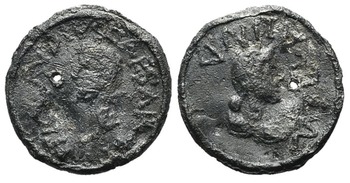
Figure 2.1 Pb token, 19 mm, 2.16 g. Bare head of Claudius left, TI CLAVDIVS CAESAR / Bust of Messalina right, MESSALINA.
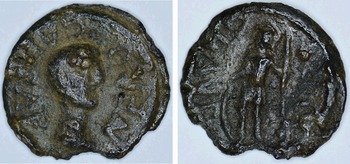
Figure 2.2 Pb token, 18 mm, 12 h, 2.48 g. Bare bust of Nero right, NERO CAESAR around / Mars (or soldier) standing left holding spear in left hand and resting right on shield, CLAVDIOR around.
Nero’s portrait on Figure 2.2 is certainly not as finely detailed as on other tokens, suggesting an authority other than the imperial government may have created this issue. Indeed, tokens offer an insight into how the imperial portrait was utilised by differing groups. Similar to provincial coinage (where imperial portraiture is used on issues struck under the authority of local magistrates) or other monuments in the capital (e.g. arches erected by the Senate and People of Rome), tokens (and their associated events) formed a medium through which particular sectors of Roman society might contribute to imperial ideology. Tokens were not long-lasting objects: they reflect the conscious use of imperial portraiture by differing groups for specific moments in time. This in turn may reflect methods of interaction with Roman imperial portraiture more broadly across Roman society: a statue or portrait of an emperor, for example, may sit ‘in the background’ of daily life for a period of time before being mobilised or re-activated for a particular ceremony or occasion, as Tran explores for the imperial imagines in the club houses of corpora in Ostia.Footnote 18 The same might be said for the imperial portrait on coinage: the faces of the imperial family might form a ‘background’ to monetary exchange until a particular set of circumstances ‘mobilises’ the image (e.g. the decision to erase the portraiture of emperors who had been subjected to damnatio).Footnote 19 Time, then, is an important dimension in understanding the roles played by the imperial image in Roman society, although not every particular context can be uncovered in the modern day.
Figure 2.3 is a clear example of a token issued by an authority other than the emperor. On one side we find a Julio-Claudian portrait (Augustus?) accompanied by the legend CAESAR, and on the other side the praenomina of the individuals responsible for the token, Marcus and Manius. The S in CAESAR is retrograde (back to front), reflecting an error in the workshop that created the mould. Unfortunately the token itself offers no further information about who Marcus and Manius were, or the context in which the token was manufactured.
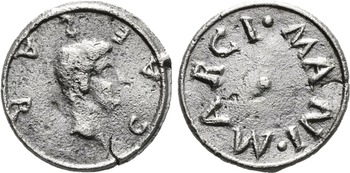
Figure 2.3 Pb token, 19 mm, 12 h, 1.7 g. Bare male head (Augustus?) right, CAESAR around / MARCI·MANI· around.
Other tokens carrying imperial portraits, however, are issued by individuals whose magistracy is specified; this is often a curator or magister.Footnote 20 The occurrence of curator (frequently abbreviated to CVR on tokens) was believed by Rostovtzeff to mostly refer to the position of curator ludorum, a magistrate in charge of games. The magistracies named on tokens might refer to civic positions or positions within smaller organisations, for example Roman youth groups.Footnote 21 The example of Gaius Mitreius has already been discussed. A further example is the cur(ator) iuv(enum) responsible for a token issue that bore a female portrait accompanied by the legend CLAVDIA AVG, a reference to Nero’s daughter Claudia Augusta who died at four months in AD 63.Footnote 22 The female bust shows a young woman with her hair tied in a bun at her neck; Rostovtzeff suggested it was perhaps Claudia’s mother Poppaea shown here rather than the deceased infant. Poppaea is shown on provincial coinage with her hair plaited and tied at the base of her neck (she is not shown on coinage struck at Rome).Footnote 23 The token may then indeed represent her. However, given the legend, it is equally likely that the portrait was intended to represent Claudia Augusta: she was the first imperial child to undergo consecratio at Rome and thus there was no established representational precedent.Footnote 24 Evidence for portraits of the deified infant Claudia exist and it has been suggested that a prototype bust of Claudia Augusta was created immediately after her death showing her as a young child, which served as a model for her representation across the Empire.Footnote 25 A surviving marble bust proposed to be Claudia does not look like the representation on the token (it shows a young child without a plait), but it may be that, in the absence of a known portrait type, the token issuer here may have simply represented Claudia in a manner akin to her mother – the quality of token designs, as we have already noted, could vary significantly. The representation may have been intended to show Claudia as the young adult she may have become, had she lived.
The legends CLAVDIA AVG and CLAVD AVGVSTA also appear on other lead tokens accompanied by a very similar female portrait. On one specimen, found in the Tiber, the portrait is paired with the legend M L D T arranged in a cross on the other side; we do not know what the legend refers to.Footnote 26 Another type carries the portrait and legend CLAVD AVGVSTA, with the portrait of Nero and the legend NERO CAESAR on the other side (Figure 2.4). For this type Rostovtozeff did not hedge his bets by describing the portrait as ‘Claudia or Poppaea’ but rather described the portrait simply as Claudia. An example of this token type was found in the Garigliano river, eighty miles south of Rome and thirty-five miles north of Naples.Footnote 27 Nero gave his deceased baby daughter the title Augusta and deified her; a pulvinar, a temple, and a priest were granted to her by the Senate.Footnote 28 It is entirely possible that Claudia, shown as a young female very similar in appearance to her mother, was incorporated into the imagery of tokens, which may have been used during celebrations in her honour, for example during her consecration.Footnote 29 Given the absence of the title DIVA, we cannot rule out the idea that some of these tokens may also have been used during the celebrations of Claudia’s birth or some other event in her short life. Ultimately, we cannot be certain as to the identification of the female figure, but the recurring reference to Claudia (and not Poppaea) suggests it is the young daughter of Nero intended here. The context in which these tokens were produced can also only be speculative.
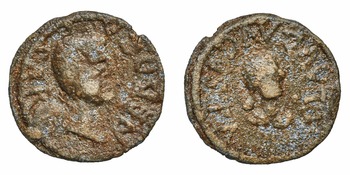
Figure 2.4 Pb token, 18 mm, 12 h, 2.92 g. Bare head of Nero right, NERO CAESAR around / Head of Claudia Augusta (?) right, CLAVD AVGVSTA.
As well as heirs, imperial ancestry might also be celebrated. One token, carrying a representation of the emperor Claudius’ mother Antonia the Younger wearing a wreath of corn-ears, specifically records that the piece was used within a ceremony of imperial liberalitas (EX | LIBERAL|ITATE TI CLAVDI | CAE AVG).Footnote 30 The token was likely used to facilitate the distribution; it might have been given to individuals during the ceremony and exchanged later for money, grain or other goods. Alternatively, the token might have granted access to the distribution. Textual accounts record the distribution of gifts by different emperors, mentioning tesserae, sparsiones and missilia – the latter two words indicate the method by which these tokens were distributed (‘scattered’ or ‘thrown’).Footnote 31 These words may not necessarily indicate the use of tokens on each occasion. They may equally describe the scattering of smaller prizes, for example meats and sweets.Footnote 32 But Cassius Dio’s mention of Agrippa, as aedile, using symbola to distribute prizes in the theatre suggests that, at least on some occasions, imperial and magisterial gifting was mediated by lead tokens.Footnote 33 The associated tokens were then designed with particular imagery to further enhance the message of the gesture and its political context.
Suetonius records that while on Capri, Augustus watched the exercises of the ephebes, and then gave them a banquet during which he distributed missilia to be exchanged for food and other goods.Footnote 34 The particular context, interaction with Italian youth, is of particular note given the assortment of tokens surviving that mention iuvenes.Footnote 35 Cassius Dio records that during a gymnastic contest Caligula scattered symbola and then distributed gifts to those who managed to get hold of one, an act that ‘delighted the rabble’ but ‘grieved the sensible’.Footnote 36 Nero is also associated with the distribution of missilia that represented multiple types of goods: grain, clothing, gold, silver, precious stones, pearls, paintings, slaves, beasts of burden, trained wild animals, ships, insulae and farms.Footnote 37
Although Fortuna is a popular motif on the surviving lead tokens in Rome and Ostia (perhaps a reference to the role of luck in managing to obtain a token thrown from above), the representation of specific goods, as described by our textual sources, remains rare. They do exist, however, and Figure 2.5 is one such example. It depicts an oyster on one side, and gives the Latin for oyster (OSTREVM) within a wreath on the other (perhaps to clarify the image). This may be an example of a token used in a distribution ceremony, imperial or non-imperial; alternatively, it might be connected to some other patronage or business in Rome or Ostia.Footnote 38 There might be several reasons why tokens like this are scarce. Most tokens may have not needed to carry such obvious imagery (goods may have been represented in other ways). Alternatively, lead tokens used in these contexts were likely, by and large, to have been redeemed, and thus do not survive to the present day. Upon presentation and exchange, one imagines the tokens were then melted down to allow the lead to be reused.

Figure 2.5 Pb token, 21 mm, 3.18 g. Oyster on an oyster shell / OSTREVM in two lines within wreath.
Numerous individuals thus likely made use of tokens to facilitate the distribution of goods or benefactions within Rome. Although lead tokens may not always have been the medium of choice on such occasions, those that survive provide insight into the array of imagery used within specific contexts and moments in time. Some of these tokens bore imperial portraits, underscoring how the imperial image might be mobilised and become ‘visible’ at particular moments in time. I now turn to a more detailed case study, which has seen far less discussion in scholarship: the use of lead tokens under the Flavian dynasty.
Triumph over Judaea under the Flavians
Two contemporary accounts of Roman ceremony and spectacle are preserved from the Flavian dynasty. Josephus’ account of the triumph over the Jewish people in AD 71 in Book 7 of his Jewish War is the fullest account of a triumph we have from the Roman Empire.Footnote 39 It was also in this period that Martial composed the Liber Spectaculorum, a collection of epigrams celebrating various spectacles put on by Domitian and/or Titus, unique among surviving classical literature in its focus on ephemeral displays.Footnote 40 Indeed, gift giving and festivals also form a focus of Martial’s work elsewhere; several of his books were published for the Saturnalia.Footnote 41 It is perhaps unsurprising that there is such a focus on this theme in authors from this period: the triumph celebrated over the Jews, the public conversion of Nero’s Golden House into areas dedicated to public consumption (embodied by the completion of the Colosseum) and the visible connection of military triumph with other building programmes around Rome were key in creating legitimacy for the new dynasty. We also possess a series of tokens that are likely Flavian in date that reference the festivals and spectacles held by these emperors, as well as broader dynastic ideology. The Flavians, then, form an ideal case study for an examination of how tokens operated within contexts connected to the emperor.
The return of Titus to Rome in AD 71 after successfully quashing the uprisings in Judaea was followed by a military triumph in the city. The occasion enabled Vespasian to advertise the new imperial dynasty.Footnote 42 In spite of Josephus’ detailed account no mention is made of imperial distributions or the use of tokens during the event; one gets the impression that Josephus preferred to focus on other matters, like the route taken through the city. The imagery of several tokens from Rome, however, suggests that these objects may have been used during the triumph of AD 71. Alternatively, imagery connected with the Jewish triumph may have been adopted for later use.Footnote 43 While there have been numerous studies of Roman triumphs,Footnote 44 the possible connection of tokens to this ceremony has, by contrast, had very little attention.Footnote 45
Scholars have frequently commented that the wreath shown on many bronze and orichalcum tokens is the corona triumphalis.Footnote 46 This need not suggest these tokens were used in triumphal ceremonies; the imagery of triumph was often adapted for use on objects within broader daily life.Footnote 47 But one particular token series carries an even closer reference to the Roman triumph (Figure 2.6). The obverse of the series carries a laurel branch, a symbol of military triumph, accompanied by the cry io, io triumphe! Surviving literature informs us that io triumphe or io, io triumphe was shouted during the triumphal ceremony.Footnote 48 Varro provides the best discussion of this phrase, noting that soldiers shouted io triumphe as they returned with the general and proceeded through the city of Rome.Footnote 49 The reverse of the token series shows articles of the dona militaria: a torque and two armillae (armbands). These items were awarded to soldiers who had performed well in battle: the tombstone of M. Caelius for example, a soldier who died during the Varian disaster in AD 9, shows the deceased with his armillae and torques.Footnote 50 It is likely that armillae are also represented on lead tokens, although this has previously not been recognised.Footnote 51
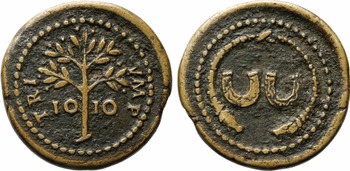
Figure 2.6 Orichalcum token, 19 mm, 3.74 g, 12 h, AD 75–125. Laurel branch, IO on left, IO on right, TRI VMP around. Dotted border / Two armillae and a torque.
The obverse of the token clearly references a triumphal ceremony, although it is by no means certain it was used in this specific context. One specimen of this series was uncovered in Rome and forms part of the ‘monete della commissione archeologica’ of the Capitoline Museums.Footnote 52 We cannot know the precise context or use of the token series, but the choice of imagery is significant. The token issuer(s) did not decorate their series with an image of the emperor in a triumphal chariot, for example, or with images of spoils or captives. Rather, the designs captured the experience of the soldiers themselves: the chant they cried and the objects some of them would have received. Tokens used in other events (e.g. religious festivals) were also designed to appeal directly to the experience of a participant, discussed more fully in Chapter 4. The choice of motifs here forms part of a broader phenomenon in token design.
The IO IO TRIVMP series was originally assigned to the reign of Domitian on the basis of what is now known to be a spurious die link with a quadrans.Footnote 53 Nonetheless, Woytek proposes that the issue should be dated to the late first or early second century AD: among the quadrantes issued by Domitian are types that have previously been identified as an olive branch but which may in fact be a laurel branch, and which form a close parallel to the representation of the branch on the token series.Footnote 54 The overall effect of the token (which survives to the present day in relatively large numbers in comparison to the Julio-Claudian numeral tokens) is extraordinary: the user is gifted a ‘laurel branch’ and the text serves to make the token speak, evoking the senses of the user.Footnote 55 Indeed, the recording of the chant, and the gifting of a ‘laurel branch’ would have created a sense of participation for the user. Even if not used as part of triumphal festivities, the legend and imagery would have evoked the idea (or memory) of a triumphal ceremony.Footnote 56 Tokens in Rome and Ostia carry far more acclamations than coins or medallions, perhaps due to their particular connection to specific events. The effect would have been to further reinforce a sense of belonging to a particular community: the process of chanting together unifies a group.Footnote 57 If a user was gifted a token before an event, it might serve to create a sense of anticipation (mediated by previous experience), while examining the piece after an event would recall the occasion in the mind of the viewer.
The imagery on several lead tokens suggests that these too must have contributed to the experience of an event and/or its memorialisation via the use of particular triumphal imagery. A lead token with a provenance of Rome and now in the BnF carries a laureate portrait that is likely Vespasian on one side and Victory with wreath and palm branch on the other.Footnote 58 A more unusual image can be found on Figure 2.7. One side displays a portrait of Vespasian, while the other side is decorated with a palm tree on a platform with two wheels. Another example of the same type is reproduced as Figure 2.8; this specimen shows that the palm tree was adorned with further palm branches on the left and right. Faint traces of this decoration can also be seen on the left of the palm tree on Figure 2.7. The palm tree became symbolic of the capture of Judaea; it was shown on coinage, for example, alone or alongside Victory, piles of armour, triumphant members of the imperial family, Jewish captives, or the defeated personification of the region.Footnote 59 The palm tree had previously appeared with Victory on coinage of Vitellius in AD 69 (unsurprising given one of Victory’s attributes was a palm branch), but under Vespasian it came to symbolise Judaea (and the associated Flavian victory in this region).Footnote 60 The representation of this mobile palm tree, however, is unique to tokens.
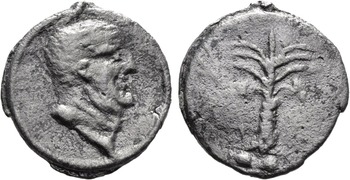
Figure 2.7 Pb token, 17 mm, 12 h, 2.95 g. Bare head of Vespasian right / Palm tree on a platform with two wheels; palm branch on left and on right.
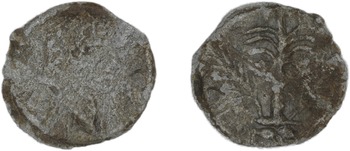
Figure 2.8 Pb token, 19 mm, 3.24 g, 12 h. Bare head of Vespasian right / Palm tree on a platform with two wheels; palm branch on left and on right.
These tokens might provide evidence that a palm tree was paraded through Rome in the Jewish triumph of AD 71; the representation of Vespasian suggests these pieces were either used in connection with the triumphal ceremony or another context during the emperor’s reign. Pliny records that a rare balsam tree, reportedly only known from royal gardens in Judaea, was paraded in the triumph of AD 71. In discussing the exhibition of the plant by Vespasian and Titus, Pliny notes ‘it is a remarkable fact that ever since the time of Pompey the Great even trees have figured among the captives in our triumphal processions’.Footnote 61 Elsewhere Pliny notes that it was an ebony tree exhibited by Pompey, during his triumph over Mithridates.Footnote 62 Östenberg suggests that these trees were exhibited alive and upright (as shown on Figure 2.7); they may have been planted after the procession was over.Footnote 63 The token imagery here may allude to a painting or image shown as part of the triumphal procession over Judaea, but it most likely represents a physical tree that was paraded through Rome. Given the central role of the palm tree to the representation of Flavian victory in the region, the presence of a physical tree in the triumphal procession is very probable.
The connection between the palm tree and the Flavian victory in Judaea is made more explicit on several other lead tokens. A worn token, now in the British Museum, displays the head of Vespasian on one side and on the other carries the image of a weeping figure (likely the personification of Judaea) beneath a palm tree.Footnote 64 The image is very close to that found on official Roman coinage, but is a mirror image, suggesting that perhaps a coin served as inspiration for the design (directly translating a coin image onto a mould would result in a mirror image of the original design on the resulting tokens).Footnote 65 Judaea beneath a palm tree is also paired with an image of Jupiter holding a thunderbolt and Victory.Footnote 66 The connection between the palm tree and the Judaean victory is also made explicit on Figure 2.9, which pairs the tree with the legend IVDE – Rostovtzeff interpreted this as a reference to Iudaea.
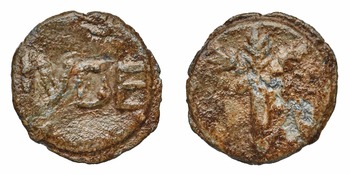
Figure 2.9 Pb token, 14 mm, 12 h, 1.94 g. IVDE / Palm tree.
Other tokens also carry an image of a palm tree, but are more difficult to connect to Flavian celebrations after the conclusion of the war. One type bears Fortuna on side a, and a palm tree accompanied by the letters T C on side b – Overbeck and Overbeck suggested the legend might refer to T(itus) C(aesar), although the suggestion remains hypothetical.Footnote 67 They further argued that TURS 1842 (Victory inscribing a shield / the letters T L on either side of a palm tree) was also a reference to the Jewish wars; various images of Victory inscribing a shield attached to a palm tree appear on Roman coinage under Vespasian.Footnote 68 Overbeck and Overbeck noted that the precise function played by these pieces is unknown: they might have been distributed in triumphal ceremonies, as a souvenir, or to be exchanged for other goods.Footnote 69 Whatever their context, they served to further consolidate the ideology associated with Flavian legitimacy.
The palm tree also appears on tokens alongside types that cannot be immediately connected to the imperial house. Accompanying designs include two corn-ears, Fortuna, Fides, Mercury, Aequitas, a rhinoceros, a horse, a deer, a flower, the legends CCS, FOR, INS, AMI, CM and a monogram.Footnote 70 These tokens need not have necessarily been used during activities sponsored by the emperor, but may have been created by others for local events as part of a broader celebration. We glimpse the existence of such associated events in Josephus’ account of the triumph of AD 71: after the arrival of Vespasian at the palace, the ‘crowds then betook themselves to festivity’ and feasted ‘by tribes and families and neighbourhoods’.Footnote 71 These very local experiences of a broader imperial celebration may have utilised tokens to control access to banquets or to manage the distribution of goods. The tokens, and the contexts in which they were used, placed imperial ideology within a hyper-local environment.
Not all tokens carrying palm trees, however, are necessarily connected to the Flavians. The palm tree, as with the palm branch, was a general symbol of victory, and supported Victory’s shield on official coinage until the early fourth century.Footnote 72 The palm tree might also be associated with victories in non-military contexts; for example it is portrayed on a North African Roman lamp next to a victorious racehorse named Regnator.Footnote 73 But the portrayal of a palm tree on its own, without accompanying images, does seem, at least in Rome and Ostia (where these tokens are most likely manufactured), to have been connected to Judaea and the Flavian dynasty. Indeed, the palm tree is found on carved marble pieces likely to come from the temple of the gens Flavia: entablature pieces from this structure are supported by stylised palm frond capitals and we also possess the remains of male caryatids who are shown with their backs against palm trunk column shafts.Footnote 74 These fragments reveal the extent to which the imagery of Jewish conquest, including the palm tree, took on dynastic associations: these were no longer specific references to a particular moment in time, but more enduring images associated with the legitimacy of a dynasty.
Given the association of the palm tree with the Flavian dynasty, Figure 2.10 is of particular interest. A male figure carrying a cornucopia stands before a tree; at the point where the two outer branches of the tree meet the trunk there are two circular shapes suggestive of dates, hinting that this representation is meant to depict a palm tree. The central pellet is the result of the manufacturing technique, detailed in Chapter 1. Rostovtzeff identified the figure as Anubis. Although the figure does have a pointed head that might indicate a snout, no ears are visible on this specimen, or on the piece now in the BnF in Paris, which was found in Rome.Footnote 75 The figure then may be a Genius. The embodiment of the people of Rome, or an association within the city, placed before a tree, and represented as the same size as the tree, may have been an instance of localised reuse of Flavian imagery for a particular local context, if the interpretation of the tree as a palm is correct. The LLV on side b of the token might be the initials of a tria nomina beginning with Lucius. The use of tokens as a medium that allowed interaction and adaptation of imperial imagery in very localised contexts is discussed further below.

Figure 2.10 Pb token, 19 mm, 12 h, 3.06 g. Nude male figure standing left holding cornucopia in left hand and reaching out with right to palm tree before him / LLV.
Striking in this context is the apparent absence on tokens of representations of the emperor as triumphator. Rostovtzeff records only two occurrences of a triumphator on tokens, shown frontally in a quadriga holding a globe in his left hand. TURS 111 carries, on the other side, the image of a military trophy flanked by the letters F P (the meaning of the legend is not known).Footnote 76 TURS 112 carries a radiate lion on the other side. The image of a male figure with a globe in a quadriga also fits the god Sol, who appears in a frontal quadriga carrying a globe from the third century AD (it is also only from the third century, under Caracalla, that a radiate lion appears on coinage).Footnote 77 Triumphing emperors are normally shown carrying a sceptre and/or branch while in procession; the presence of a globe here does suggest Sol may be the better identification.Footnote 78 The radiate lion, although an uncommon image, seems to be connected with Sol; the god’s connection with military victory, particularly in the East, also fits well with the choice of a military trophy as an accompanying image.Footnote 79 The seeming absence of the triumphator from tokens is a mystery, one that further research may help to illuminate.
The imperial family do appear in other ways on tokens. As with the Julio-Claudian period discussed above, a dynastic emphasis is found on Roman lead tokens under the Flavians. These tokens may have been manufactured in association with the triumph of AD 71 (the first time the entire dynasty was presented to the Roman people), or at some other point during Vespasian’s reign.Footnote 80 Figure 2.11, showing and naming Vespasian on side a, and his two sons on side b, closely recalls coinage issued by the emperor in AD 70 (Figure 2.12).Footnote 81 But there are also significant differences between the token and the coin. Both Titus and Domitian are shown laureate on the token, with the ties of the wreath flowing down behind their necks.Footnote 82 By contrast, both are bare headed on the coin issue. A globe is also placed between the busts on the token, reminiscent of a brass token showing the twin sons of Drusus the Younger, Tiberius Gemellus and Tiberius Germanicus, whose facing busts also had a globe placed between them.Footnote 83 The placement of the IMP and CAES on the token is ambiguous: the IMP likely only refers to Titus, but its association with Domitian cannot be ruled out (especially since Domitian is laureate); both Domitian and Titus also bore the name Caesar. In sum, the token takes numismatic imagery to a different level: the temporary nature of the medium, created for a particular (presumably receptive) audience at a particular moment in time, meant that certain ideas and messages might be expressed which did not otherwise feature on other forms of material culture.

Figure 2.11 Pb token, 19 mm, 12 h, 2.74 g. Laureate head of Vespasian right; IMP AVG VES around / Laureate heads of Titus (on left) and Domitian (on right) facing each other, globe between them; IMP (ligate) above and T DO CAES below.
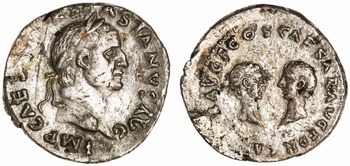
Figure 2.12 AR denarius, 17.5 mm, 6 h, 3.22 g. Laureate head of Vespasian right, IMP CAESAR VESPASIANVS AVG around / Bare head of Titus on left facing bare head of Domitian on right, CAESAR AVG F COS CAESAR AVG F PR around. RIC II.12 16.
We cannot know when in Vespasian’s reign Figure 2.11 was produced; the coin imagery may have been adapted years after it was issued. The laureate heads of Titus and Domitian (without the globe) are also found on another token series; the other side of this issue shows a horse rider carrying a spear with the legend IMP AV VES.Footnote 84 Bronze coinage under Vespasian carries an image of Titus on horseback spearing a fallen enemy, but the accompanying legend on the token suggests that it is Vespasian who is shown here.Footnote 85
Whatever the specific context of these tokens, their imagery would have contributed to the emotion, experience and memories of certain events. At particular moments in time the image of the imperial family, as well as other imagery closely associated with the emperor and his achievements, were mobilised to underscore the connection of a specific occasion to the imperial house. Imperial imagery would also have communicated status and prestige. We also find this during the spectacles given in conjunction with particular festivals. It is to these we now turn.
Spectacles and the Colosseum under Titus and Domitian
The Flavian triumph in the Jewish War translated into a permanent dynastic ideology through the erection of monuments in Rome, most famously the Colosseum opened by Titus in c. AD 80.Footnote 86 In his account of the spectacles staged by Titus in connection with the opening of the amphitheatre Dio records that the emperor ‘would throw down into the theatre from aloft little wooden balls variously inscribed, one designating some article of food, another clothing, another a silver vessel or perhaps a gold one, or again horses, pack-animals, cattle or slaves. Those who seized them were to carry them to the dispensers of the bounty, from whom they would receive the article named.’Footnote 87 Here we have a detailed account of how tokens (in this case wooden spherical tokens) operated to facilitate distributions during a particular event.
The opening of the Colosseum and the events that followed also served as inspiration for Martial’s Liber de Spectaculis.Footnote 88 Martial’s focus on the consumer culture of Flavian Rome, the playfulness he employs with regards to size (shrinking big to small, transforming small to big), and his project to monumentalise otherwise ephemeral moments means it is little surprise that he mentions tokens on several occasions.Footnote 89 The most discussed text of Martial in this regard is 8.78, which was likely written in response to the games of AD 93 held by Lucius Arruntius Stella to celebrate the return of Domitian from the Sarmatian War.
Each day has its gifts. The wealthy cord takes no holiday and ample plunder falls into the crowd. Now come sportive tokens (lasciva nomismata) in sudden showers, now the lavish coupon (tessera larga) bestows the animals they have been watching, now birds are happy to fill safe laps and find masters in absence by lot, lest they be torn apart.
The phrase lasciva nomismata has been the subject of scholarly discussion: the phrase was previously thought to refer to spintriae carrying sexual imagery on the basis that lasciva meant pornographic, but this view has now been discounted.Footnote 91 Buttrey argued that lasciva might have been intended to characterise the way the tokens fell from the sky, but, as explored in this volume, metal tokens can also carry playful or satiric imagery that might justify the use of the adjective. Nomismata refers to coinage or a coin-like object, like a token. In this passage then it seems that Martial is referencing the use of monetiform tokens to aid in the distribution of gifts during games celebrating Domitian’s military success. Indeed, the word tessera in the text also suggests the use of tokens to distribute the meat of animals slaughtered in the arena.Footnote 92
Elsewhere Martial uses nomismata in the sense of a token to be exchanged for something else. Two separate epigrams focus on one Sextilianus, who, by taking the nomismata of his neighbours at a show, managed to drink enough for five rows; although equites were only given ten nomismata each, Sextilianus managed to procure twenty drinks.Footnote 93 Nomismata are also given out at the Saturnalia (the connection of lead tokens with this festival is discussed in Chapter 4).Footnote 94 The term may not indicate tokens in each occurrence: Martial also reports nomismata found in a goose and these may be coins or tokens.Footnote 95 Given Martial’s frequent reference to money and the consumerism of Rome we should not be surprised that the poet also uses references to lead tokens in order to communicate his themes. Indeed, although his use of plumbeos to characterise his earnings as a poet has been translated as ‘coppers’ or small denomination coins, one wonders whether Martial in fact was referring to lead tokens. Being paid in lead tokens that could only be exchanged for goods from an individual’s holdings paints the poet as a client subject to his patron even more so than someone who was paid in low denomination coinage (which would at least offer the freedom to purchase whatever one might desire within one’s means).Footnote 96
Lead tokens, as small objects that referenced much larger benefactions, may also have appealed to Martial as objects: in his work he also used small poems to reference larger events, and, like tokens, he captures a fleeting moment.Footnote 97 One can see this particularly in his epigrams focusing on the games, the Liber Spectaculorum. In two epigrams Martial presents the two-horned rhinoceros Domitian famously exhibited at Rome, which also appears on quadrantes struck under the emperor. Buttrey uses the dates of the coins to date the spectacle to AD 83–5.Footnote 98 Rhinoceroses were rarely displayed in the capital, and the capture and presentation of a specimen with two horns must have caused a sensation. Like Martial’s poems, the coins would have served as a long lasting reminder to the citizens of Rome of Domitian’s spectacular games. One poem celebrates the rhinoceros defeating a bear, while in the other the animal defeats a bull. The latter poem is strikingly similar to a lead token that shows a two-horned rhinoceros on one side and a bull on the other (Figure 2.13). Martial also details a fight between an elephant and a bull, a pairing that is also shown on lead tokens.Footnote 99

Figure 2.13 Pb token, 23 mm, 6 h, 5.6 g. Rhinoceros with two horns standing right; crescent above / Bull walking right.
This token series, and other tokens carrying the image of a two-horned rhinoceros, may have been used during the games held by Domitian in which the rhinoceros appeared, or the imagery may have been appropriated for occasions after the event. On gems and intaglios the rhinoceros was a symbol that communicated victory.Footnote 100 In addition to the bull, the rhinoceros with two horns is paired with a bison and a rooster (carrying a wreath in its beak) on tokens.Footnote 101 Four specimens of the rhinoceros / rooster type were found in the Tiber river in Rome; the rooster may reference Mercury.Footnote 102 On another type the legend AVR is placed above the rhinoceros and a palm branch is depicted on the other side.Footnote 103 One type carries the image of a rhinoceros with a single horn, but has a palm tree on the other side, suggesting a possible connection with the Flavian victory in Judaea.Footnote 104
Whether these tokens were used during games in Domitian’s honour or some other event, they would have served to heighten anticipation (if distributed before the animal fights) or consolidate one’s memory of an occasion (if distributed after the fight). It is difficult, if not impossible, however, to connect particular tokens to particular games. The same problem applies to Martial’s Liber Spectaculorum: one imagines, with the exception of the rhinoceros, that similar contests were held on multiple occasions; this is what makes dating the work to the reigns of either Domitian or Titus so tricky. Regardless of these difficulties, however, both sources provide important insights into the emotions, activities and experience of spectacle in the Flavian age.
Overbeck suggested that a bone token, carved with an image of the Colosseum accompanied by the legend COS on the left and XII on the right, might have been connected with celebrations associated with the opening of the Flavian amphitheatre under Titus.Footnote 105 The other side of the token carries the legend FLA COS VES XII around in a circle, with each word clearly delineated from the others via a series of lines. The overall decoration suggests that the legend should be read from left to right and then up and down: FLA VES COS XII. Overbeck noted the piece might also be a gaming token. A bone piece now in the BnF offers a parallel: one side bears a representation of the Colosseum and the other side a number (VI); this particular piece has been pierced, perhaps for later conversion into a necklace pendant (Figure 2.14).
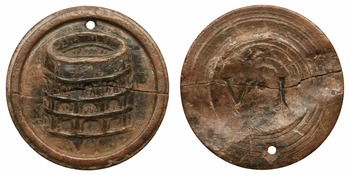
Figure 2.14 Pierced bone gaming piece (?) showing the Colosseum on one side and VI incised on the other. Froehner 282.
Bone gaming pieces often carry a number on one side, as on Figure 2.14. The mention of a twelfth consulship, and the absence of a number, would make the piece published by Overbeck unusual if it were a gaming piece. A similar bone piece, with no image and only a legend, is in the David Eugene Smith collection in Columbia University. One side carries the engraved legend L·LVCIVS·CONS·II and the number II is engraved on the other side – perhaps a number used in a game, but more likely a second reference to the number of consulships held by Lucius.Footnote 106 For the Colosseum piece published by Overbeck, the number of consulships may hold the clue to the date: Titus never held twelve consulships (nor did Vespasian), so it is unlikely the piece was created for the opening of the Colosseum. It was Domitian who obtained a twelfth consulship in AD 86, and this piece may then be connected to events held in that year; the representation of the Colosseum, accompanied by the reference FLA VES, served to reinforce the dynastic connections of Domitian. The purpose of these rare bone pieces mentioning magistracies still needs further research. The material and labour involved suggests they might have served a different (more long term?) purpose than their lead counterparts.
After the death of Vespasian, tokens continued to reference Titus and Domitian. One issue shows the busts of the brothers facing each other, with Fortuna on the other side accompanied by the legend SEM.Footnote 107 This type may equally have been produced during the reign of Vespasian. During the rule of Domitian and Titus, there seems to be a shift in the design of tokens bearing reference to the emperor: portraits disappear, and the emperors are referred to only via a legend (Figure 2.15).Footnote 108 This practice seems to continue into the reign of Domitian: two token series carry nothing but legends, naming Domitian as imperator and connecting him to the deified Vespasian.Footnote 109 The abbreviation of the emperors’ names here (T and DOM) echoes their representation on coin legends under Vespasian.Footnote 110 Why there should be a shift in representing the imperial family on tokens at this time is difficult to explain; it may be part of a broader process by which reference to the emperor on these objects slowly disappears.Footnote 111
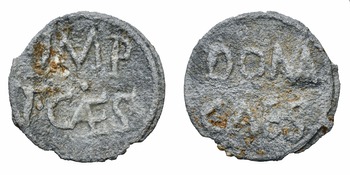
Figure 2.15 Pb token, 19 mm, 12 h, 1.77 g. IMP | T·CAES (AE ligate) / DOM | CAES.
Overall, reference to the Flavian emperors on tokens emphasises dynastic connections, and the foundational moment of the dynasty, the Jewish War. Other themes, for example the very public connection between Domitian and Minerva communicated by coinage, appear to be absent.Footnote 112 Tokens bearing representations of Minerva may indeed have been used during the reign of Domitian, but the image of the goddess was not directly placed alongside the emperor, meaning we have no way of deducing the date of tokens carrying the goddess’ image. The ideology used during particular occasions, during festivals and their associated feasts and distributions, differed from the imagery that was placed on coinage for repeated daily use over time. A person’s experience of the imperial image was thus very much dependant on one’s location and the events one attended. Ephemeral events had an important role in shaping the ideology and culture of a dynasty, epitomised in Martial’s poetry.
Tokens that Speak: Imperial Acclamations
As the triumphal token discussed earlier illustrates (Figure 2.6), tokens might carry acclamations. As Kuhn observes, chants served to create an ad hoc emotional community, a ‘we-feeling’ generated by common expression.Footnote 113 The presence of these cries on tokens is a further insight into the role of these artefacts in building different types of communities. Several tokens carry imperial acclamations, most commonly expressions of good fortune (feliciter) for the emperor (non-imperial acclamations are examined in more detail in Chapters 3 and 4).Footnote 114 The earliest numismatic acclamation we possess occurs on a token carrying a portrait of Augustus with the legend FEL beneath (Figure 1.2).Footnote 115
Often feliciter is abbreviated to F, as seen on a bronze token dated to the second half of the first century AD (Figure 2.16). The sceptre shown on this token is topped with what is likely an imperial bust; Woytek consequently connects this piece with the praeses ludorum, the overseer of games in Rome that drove in the procession to the circus (pompa circensis) in a biga carrying a sceptre.Footnote 116 The obverse carries a wreath that has been identified as the corona Etrusca, the golden wreath held over the head of a triumphator by a slave, and which also became associated with magistrates who offered games.Footnote 117 The token, then, carries images associated with the pompa circensis. Woytek suggests the legend might be understood as A(ugusto) P(atri) P(atriae) F(eliciter) – ‘good fortune for Augustus, father of his country’. This phrase is also found in Petronius as a toast, and an abbreviated form, Augusto feliciter, occurs as a graffito in the House of Maius Castricius in Pompeii.Footnote 118 Unlike earlier suggestions for the abbreviation – such as A(pollinares/-aria) P(ecunia) P(ublica) F(iunt) or F(acti/facta) – Woytek’s solution fits well with what we know of tokens more broadly. As demonstrated throughout this volume, feliciter (or an abbreviation thereof) appeared on tokens with relative frequency; Figure 2.17, for example, also carries the abbreviation PPF, here in reference to Hadrian. For the abbreviations to have been understandable one imagines they must have been employed with relative frequency within Rome.
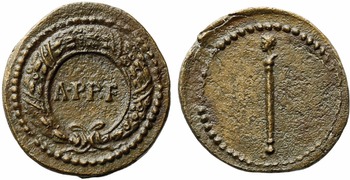
Figure 2.16 AE token, 18 mm, 2.72 g, 7 h. A·P·P·F within wreath. Dotted border / Bust-topped sceptre left. Dotted border. Reference RowanRowan, 2020b: no. 21.
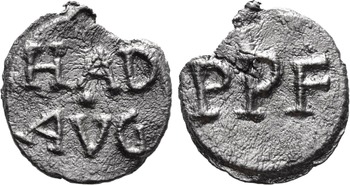
Figure 2.17 Pb token, 18 mm, 12 h, 3.04 g. HAD | AVG / PPF.
The reference to the praeses ludorum highlights that many of the acclamation tokens were likely created as part of a wider festival or event. The placement of an imperial bust on a sceptre to be held by the presiding magistrate during a public procession, alongside the parade of imperial cult images that occurred within the pompa circensis (or the pompa theatralis, theatrical processions) form a very real example of how the imperial image might be ‘mobilised’ at a particular moment in time (the imperial busts that were placed atop sceptres, for example, were likely stored in temples when not in use, including temple porches and porticoes).Footnote 119
The carriages that bore the statues or exuviae (attributes) of the imperial family in the procession to the circus are also represented on tokens, for the deified Augustus, for Livia and for Trajan. These tokens may have been used during particular events that had a pompa circensis. However one cannot exclude the idea that the tokens took their imagery from Roman imperial coinage, which also showed representations of the carpenta (carriages used for women), tensae (wagons that carried cult images) and elephant chariots that bore imperial statues and paraphernalia in these processions. The token series carrying the representation of four elephants with riders pulling a statue of Augustus, for example, is very similar to a scene found on Tiberian coinage.Footnote 120 Another token series carries a portrait of Livia on one side and a carpentum (a wagon drawn by two mules) on the other. The type is also reminiscent of coinage, but on at least one specimen the curator of the games adds his name: L SEI.Footnote 121 Since game giving and the associated processions to the venue was one of the few remaining avenues in which the Roman elite might visibly increase their prestige during the imperial period, it is not surprising that tokens (likely used at some point during the event, if not in the procession) should represent the pompa; such representations are also known from other non-imperial monuments celebrating the achievements of Roman citizens.Footnote 122
Tokens connect a tensa with the emperor Trajan; no other evidence exists that Trajan was awarded this honour. This token issue, then, created a combination of imagery not found on official coinage, likely to specifically communicate the presence of Trajan’s cultic imagery in a procession.Footnote 123 Two other token types carry tensae: the first is drawn by four lions with a palm branch shown on the other side, and the second drawn by two elephants with Mercury shown on the other side.Footnote 124 An elephant biga was awarded to Titus’ daughter Julia by Domitian, as well as to the deified Nerva and Faustina I, but without further information we cannot know what deities (imperial or otherwise) were connected with these particular carriage representations.Footnote 125
Festive occasions that utilised tokens may have also included the dies imperii, the anniversary of the day an emperor came to power. An antiquarian report on the collection of Capranesi found in Rome records the existence of a token that bore the legend DIEI | IMPE|RI on one side and HADR | AVG | FEL on the other – a wish of good fortune (fel(iciter)) for Hadrian Augustus on his dies imperii.Footnote 126 Other token types also communicate good wishes for Hadrian and Sabina. Figure 2.17, for example, expresses good fortune (F) for Hadrian Augustus (HAD AVG), father of his country (PP). Another token issue carries the legend FEL | SABI on one side and the legend AVG | HADR | SAL on the other.Footnote 127 Here the FEL likely refers to Sabina as felix (happy or lucky), as long as Hadrian is safe and healthy (Aug(usto) Hadr(iano) salvo). The use of the word salvus in connection with the emperor is also known from acclamatory inscriptions, as well as tokens of urban prefects in late antiquity.Footnote 128
The few imperial acclamations that appear on coins and medallions also suggest festive contexts. Coins and medallions issued under Hadrian and Antoninus Pius wish the emperor a happy and auspicious new year on behalf of the Senate and People of Rome.Footnote 129 Suetonius records that Claudius was greeted with feliciter while presiding over the games, as were Domitian and his wife in the Colosseum.Footnote 130 Acclamations formed an important interaction between the emperor and the populace. One wonders whether tokens, distributed in advance of or during an event, may have served to help provoke these ‘spontaneous’ exclamations. Alternatively, if distributed after an occasion, these tokens reveal that ‘spontaneous’ acclamations were, in fact, perhaps expected at particular occasions as part of the experience (hence the pre-manufacturing of tokens carrying such cries). It is evident that emperors might encourage or indeed orchestrate acclamations in the theatre or amphitheatre: Suetonius records that Nero organised and planted young men to cheer and applaud him when performing.Footnote 131 Tokens may also have formed a device of encouragement.
The legend FELI AVG is also found on two tokens that carry a reference to the golden age (SAEC AVRE).Footnote 132 Rostovtzeff interpreted the legend to mean Saec(ulum) aure(um) feli(x) Aug(ustus); the fact that abbreviations of feliciter tend to occur at the end of token legends suggests felix is probably the correct choice here. Rostovtzeff recorded that on one token issue the legend SAEC AVRE was accompanied by an image of Victory, but close examination of a specimen now in the British Museum suggests that the standing figure is carrying a crook in their right hand and a circular object (shield?) in their left.Footnote 133 The identification of this figure thus remains uncertain. The SAEC AVRE and figure design is combined with a laurel tree on one type, and the figure of Fortuna on a second type. Both of these issues carry the legend FELI AVG on side b. Hadrian was the first to proclaim a golden age on official Roman coinage, but the concept is found throughout the imperial period.Footnote 134 The tokens might be connected to a saecular festival of some kind; Hadrian’s proclamation of a golden age in AD 121 indicates that this proclamation need not align with the celebration of the official saecular games.Footnote 135 That the felicitas or the luck of the emperor was connected to a golden age is not surprising: the benevolence of the gods towards Rome’s ruler naturally meant prosperity for the broader empire.Footnote 136 The emotion captured by the use of felix on tokens in connection with the imperial family is very similar to that of feliciter, and reflects the atmosphere that must have prevailed upon festive occasions.
Tokens, Imperial Ideology and Roman Triumphal Arches
In addition to the giving of games, other acts of euergetism offered an opportunity for the Roman elite to enhance their prestige. Tokens offered a medium to regulate these acts of generosity while reinforcing the status of the patron. It is thus unsurprising that imperial ideology was adapted by a range of individuals for the decoration of tokens to be used in different contexts: the use of imperial imagery would have served to enhance the prestige of the giver. This practice, discussed in detail throughout this section, reveals how the population engaged with particular ideologies and adapted them for their own contexts. Rather than a clear-cut direct message, tokens and other everyday media reveal that the prevailing imagery of the day might have gained multiple associations over time.
Tokens issued by those outside the government creatively referenced the imagery and materiality of Roman coinage (size, shape, placement of legends and portraiture). This practice included the adaptation of specific imperial imagery. For example, a lead token found in the Tiber carried the image of crossed cornucopiae, each topped with a small head, with the legend LAS on the other side (perhaps the initials of a tria nomina). The image of heads atop crossed cornucopiae is otherwise known from the coinage of Tiberius, where the heads are believed to represent Tiberius Gemellus and Germanicus Julius Caesar; the type is also used on the coinage of Antoninus Pius and is believed to reference the twin children born to Marcus Aurelius and Faustina the Younger.Footnote 137 The image may have been selected for a token series that was to be used within a particular event honouring the imperial family; alternatively the image may have been selected to communicate fecundity, prestige or some other message. The token itself demonstrates that imperial coinage was viewed, and that people actively interacted with numismatic imagery.
Some tokens connect to imperial ideology not shown on the official coinage of Rome. A series of tokens, for example, show Hadrian’s deceased lover Antinous wearing an Egyptian hem-hem crown with the numeral VIII placed on the other side (Figure 2.18).Footnote 138 Each of the four known specimens has been subject to a circular punch, which on Figure 2.18 has resulted in a hole in the token to the right of Antinous’ bust. One wonders whether this was a mark to indicate that the token had been redeemed. These tokens possess a chunky fabric unlike the majority of tokens found in Rome and Ostia; they may have been manufactured elsewhere in Italy.
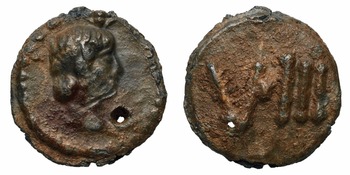
Figure 2.18 Pb token, 20 mm, 12 h, 9.42 g. Bust of Antinous right wearing hem-hem crown. Dotted border / VIII.
The cult of Antinous spread throughout the Roman world after his death, and he is frequently represented on tokens in Egypt with the hem-hem crown.Footnote 139 In Italy the cult is perhaps best known through the cultores Dianae et Antinoi in Lanuvium, a collegium focused on the cult of Diana and Antinous.Footnote 140 Among the preserved laws of the association is the stipulation that a feast would be held on the birthday of Antinous (natalis Antinoi); one wonders whether the tokens carrying images of Antinous were used in similar feasting or distribution contexts by other groups whose existence has not been preserved in the epigraphic evidence. A further lead token type carries the legend ANTINOI on one side and the image of Fortuna on the other: the use of Antinous in the genitive here may refer to his birthday, or else an association in his honour.Footnote 141 Although relatively neglected in the discussion of Antinous’ cult, these tokens contribute to our understanding of how the newly created god was celebrated within Italy.
Overall, however, identifying instances in which specifically ‘imperial’ ideology was adapted on tokens in Rome and Ostia remains difficult. Many of the images that graced the coinage of the emperors (deities, modii, clasped hands, eagles, etc) also appear on tokens but were not specifically ‘imperial’ per se – they formed part of the broader iconography of Roman everyday life. The impression formed by the surviving token corpus from Roman Italy suggests that direct engagement with imagery that specifically references the imperial family (e.g. representations of the emperor performing various activities) is rare on tokens. Direct references to the imperial family may not have been the most appropriate imagery within many of the contexts in which tokens were used (events or distributions sponsored by individuals or associations).
Coinage influenced the design of at least some tokens, but what of other monuments? Representations of structures from Rome on tokens are rare, but several tokens carry representations of triumphal arches. Here it might be significant that these arches were traditionally decreed from the Senate and People of Rome to the emperor: their authorship, in a sense, was not directly imperial.Footnote 142 One token type carries a triumphal arch on one side with what may be the head of an emperor on the other.Footnote 143 Other tokens, however, carry legends that suggest the initiative of other individuals (and we cannot rule out that the token carrying the possible image of an emperor was created by someone outside the imperial government). A triumphal arch is found on tokens variously accompanied by the legends DC, SEX CL and RŃR (Figure 2.19), which suggest the initiative of individuals or groups.Footnote 144 On some issues there is an effort to indicate a specific arch through the inclusion of the statuary group atop the structure. On Figure 2.19 this took the form of a horseman or quadriga (the precise details on the known specimens are worn). By contrast, on the issue of SEX CL an elephant standing right was placed atop the structure.
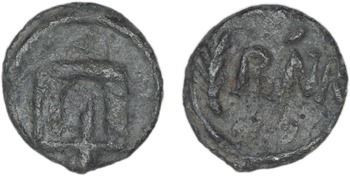
Figure 2.19 Pb token, 12 mm, 12 h, 0.89 g. Triumphal arch (surmounted by the statue of a horseman right?) / RŃR, palm branch on left.
It has long been recognised that the representation of monuments on coins is not a photographic or realistic representation, but rather reflects an engraver’s conceptualisation of a structure and what made it distinctive.Footnote 145 On several of the tokens showing arches, the statues shown atop the structure are relatively large; this is reminiscent of architectural numismatic representations in the early Empire (from the late first century AD the representations of such architectural features become smaller).Footnote 146 This development may provide a possible date range for these particular tokens of the early first century AD.Footnote 147 Indeed, it was only under Augustus (after 29 BC) that arches are represented on coins, and a quadriga, a horseman and elephants appear as sculptural decoration on arches on coinage in the Julio-Claudian period.Footnote 148 Given the rather schematic representations, however, it is not possible to connect a particular image on tokens to a specific monument.
Why would these arches be selected for representation on tokens? The individuals or groups involved might have been involved in their construction; a potential parallel are the monuments shown on the tomb of the Haterii, which probably reflect the work of a public building contractor. Alternatively, the arches may have been important in forming a sense of location or identity; the role of the physical landscape of Rome and Ostia in formulating identities is explored more fully in Chapter 3. The arches may have communicated triumph and been used during imperial triumphal ceremonies or on other occasions that invited imagery of victory. Or the tokens might have been used during ceremonies connected with the structure’s dedication.
Indeed, the possible context of these pieces may be even broader, as suggested by a so-called ‘cake or pancake mould’ found in Poetovio in Pannonia. Although we cannot definitively know what product these moulds produced, it is generally agreed they were used to create edible or wax items, perhaps a form of missilia (gifts that were thrown to crowds); the designs suggest a connection with festivals.Footnote 149 The mould found in Poetovio shows an intricately decorated triumphal arch surrounded by statues and surmounted by a statue group showing the emperor in a quadriga being crowned by a Victory on either side and flanked by military trophies. An inscription is placed on the arch: VOTIS X ET XX FEL.Footnote 150 The text references the vows taken every five years by the emperor for successful rule. This particular ruler had reached ten years of rule (his decennalia) and had made vows for his second decade in power.Footnote 151 The FEL recalls the good wishes (feliciter, felix) of the tokens discussed earlier in this chapter. Here the triumphal arch was utilised to commemorate imperial vows, with the monument perhaps expressing the idea of military victory and skill. The arch, then, might be employed in multiple contexts; the meaning of a particular monument might change according to time and context. The representation of arches on coins of Augustus commemorating building works, for example, likely communicated the idea that road construction was a triumph over nature.Footnote 152 The representation of arches on tokens may also have been performed within a ceremonial occasion such as imperial vota, or been used to communicate the idea of victory more broadly.
A triumphal arch also appears on a lead token from Egypt (Figure 2.20). The Roman imperial government controlled the mint at Alexandria – unusually for a province – with the result that local coin imagery closely reflected that at Rome, including the representation of triumphal arches erected in the capital.Footnote 153 Whether the image of arches on Alexandrian coinage represented actual structures or was a ‘stock type’ is debated, but representations included the image of a triple span arch surmounted by a quadriga, as found on the token. A coin may have thus inspired the design of Figure 2.20, although the imagery has been paired with Venus instead of the imperial portrait. It is unlikely the Egyptian token was used within the context of a triumphal ceremony; the semantic flexibility of the arch is again revealed. Although at first sight the imagery on the token seems quite Roman, the presence of the snake on the right of Venus recalls the famous agathos daimon of Alexandria. The embodiment of good luck and health, the agathos daimon here probably communicates the same sentiment that feliciter or felix does on tokens from Rome and Ostia.

Figure 2.20 Pb token from Egypt, 20.5 mm, 5.10 g. Venus standing raising her hands to her hair, snake on right and cupid (?) on left / Triumphal arch surmounted by frontal quadriga. Dattari-Savio Pl. 323, 11706 (this token).
Imperial Tokens after Hadrian and Changing Attitudes to Imperial Euergetism
From the surviving evidence, it appears that representations of the imperial family on tokens in Italy became less frequent from the second half of the second century AD. This may be due to a change in the mode of representation that makes imperial portraiture harder to identify. Several tokens, for example, carry portraiture whose style is of the second century AD, but have no legends: a uniface token from the Garigliano, for example, carries a portrait of Marcus Aurelius.Footnote 154 Another, now damaged, token carries two male busts (one on each side): Rostovtzeff identified these as second century in date, and suggested one was likely an emperor of the Antonine age, with the other perhaps Galerius Antoninus, the son of Antoninus Pius who died before his father ascended to the throne (Figure 2.21). Galerius also appears on select provincial coins, but given the preservation of the token and the lack of an identifying legend it is difficult to make a concrete identification.Footnote 155 A clear portrait of Antoninus Pius (without an identifying legend) can be found on a token now in the BnF; on the other side of the token is the worn legend VNISATIS around in a circle. The meaning of the legend is not clear.Footnote 156

Figure 2.21 Pb token, 27 mm, 6 h, 11.08 g. Bearded bare male bust (of an emperor?) left / Bare young male bust (Galerius Antoninus?) right.
Similar uncertainty attaches itself to further tokens that may reference emperors of the second and third centuries. One example, found in the Tiber, carries the legend IMP within a dotted border on one side and the legend MAC on the other.Footnote 157 Rostovtzeff suggested the legend might be resolved as Imp(erator) M. A(urelius) C(ommodus), but he remained uncertain. Indeed, MAC might equally reference the tria nomina of a particular magistrate or individual creating the token. On a further series Rostovtzeff was not sure whether the bearded bust on the token was Hercules or Caracalla: the two specimens that survive suggest Hercules is the correct identification, but the example demonstrates the issue of identifying imperial portraits on media that are of varying quality and without legends.Footnote 158 There may then be more imperial portraiture on tokens than scholarship to date has managed to identify.
The Severan dynasty seems to be completely absent on Italian tokens, although they do appear on tokens issued in other regions. Julia Domna is perhaps shown on tokens at Ephesus and Caracalla on what is likely to be a token from Lyon, although these issues do not have a legend and possess the same identification problems as those above.Footnote 159 Indeed, after the Antonines the next appearance of an emperor in Rostovtzeff’s catalogue is a single token type for Carinus, who is named on a lead token carrying the number IIII.Footnote 160 Emperors then reappear in number on bronze tokens in late antiquity, particularly in connection with the festival of Isis.Footnote 161
How can this shift in imperial representation on tokens from Roman Italy be explained? It might be an accident of preservation, but many of the tokens with known findspots in Ostia come from second century AD contexts (discussed more fully in Chapter 5); the absence of imperial portraiture on tokens in this region during this period appears to be real. It is perhaps significant that there was a slow transformation of elite attitudes towards imperial euergetism over the first and second centuries AD. At the beginning of the principate imperial acts of liberalitas only underscored the inequality between the emperor and the elite, undermining the idea of the ‘first man among equals’; it is thus no surprise that Augustus avoided the phrase in his Res Gestae. But the slow acceptance of imperial liberalitas by the elite from the reign of Trajan meant that this virtue could be communicated more widely to the population of the empire. By the second century, liberalitas was publicly associated with the emperor, appearing on inscriptions naming Trajan (as well as Pliny’s Panegyric) and on coinage under Hadrian.Footnote 162 As a result of this shift, reference to imperial munificence may have moved from tokens to more durable, far reaching media. Imperial generosity and euergetism could now, without issue, be widely advertised and celebrated across the empire.Footnote 163
The first specific use of liberalitas in conjunction with an emperor occurs under Claudius, on a token likely used during an event associated with his deified mother Antonia.Footnote 164 There is a significant gap between this occurrence and the mention of the virtue in Pliny’s Panegyric, although the depiction of congiaria distributions on coinage from the reign of Nero onwards represented one particular aspect of imperial benefaction.Footnote 165 We should note that the appearance of the phrase on the token and the representation of congiaria on coinage are both representations of specific acts of euergetism for specific groups of people. The token would have been used within a specific context for a specific group within Rome, who were presumably accepting of the inequality between giver (emperor) and receiver.
Similarly the representation of congiaria in Rome on coins under Nero and Trajan communicates that this is a specific occasion for a particular group of people.Footnote 166 Numismatic imagery shows different moments from a specific event; on Figure 2.22 for example, the emperor is seated on a platform with a recipient receiving their allotment of coinage below.Footnote 167 Architectural details are also occasionally added to locate the scene within a specific space, and the distributions are even numbered: CONG I, II, etc. It is also perhaps no coincidence that these scenes occur on bronze coins, whose circulation was confined to the west. Congiaria consisted of distributions of money to the Roman plebs; within this very specific occasion the liberalitas of the emperor and the inequality between giver and receiver was clear and unlikely to cause consternation among the Roman elite. The ceremony was thus acceptable for commemoration on bronze coinage (sestertii).Footnote 168
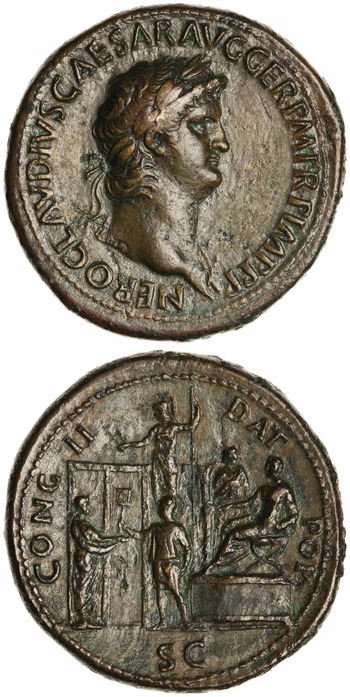
Figure 2.22 AE sestertius, 40 mm, 6 h, 26.16 g. Laureate head of Nero right with aegis on his neck, NERO CLAVDIVS CAESAR AVG GER P M TR P IMP P P around / Nero, bare-headed and togate, seated left on platform; praefectus annonae standing behind; in front, attendant standing left, giving distribution of coins to citizen right; statue of Minerva facing left behind holding owl and spear; tetrastyle building to left, CONG II DAT POP S C. RIC I2 Nero 160.
Shifting elite attitudes towards imperial liberalitas meant that from the early second century the virtue might be celebrated in a more abstract manner. It is under Hadrian that Liberalitas appears as a personification standing alone on coinage: this abstract representation might evoke different occasions of imperial generosity in the mind of the user. The imperial government decided to communicate imperial munificence and benefaction on media that circulated throughout the empire. This may have come at the expense of specific representations on tokens, whose audience can only have ever been small. This might explain the gradual disappearance of the imperial portrait from tokens during the later second and third centuries, if the disappearance is in fact genuine. That said, any specific connection of tokens carrying imperial portraiture with imperial distributions is tiny, with concrete evidence linked only to the single specimen of Claudius discussed above. Without further evidence, we can only speculate.
The disappearance of imperial portraiture can also be traced on bronze and orichalcum tokens: after the Julio-Claudians, no imperial portraits appear on tokens made from these metals either. Whatever the reason, there was clearly a shift in the design culture of tokens. One imagines that distributions and give-aways must still have taken place in the late second and third centuries. It may be that over time tokens as a medium moved away from referencing the coins they so closely resembled in the Julio-Claudian period. This chapter has already noted the shift from the portraiture and legends of Julio-Claudian tokens to the practice of representing the emperor via a legend from the later first century. The development of types may have continued to move further away from coinage, resulting in a decrease in the use of imperial portraiture in favour of other representations (deities, everyday items, animals, chants, etc). In this way tokens might reflect the development of festival iconography, selected and cultivated to enhance the emotional response of the user and their experience of a particular event. Without further evidence it is difficult to be conclusive, but the disappearance of imperial portraiture from tokens is a trend that may tantalisingly reflect a broader shift in the materiality associated with euergetism and festivals in Rome.

























